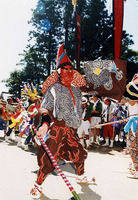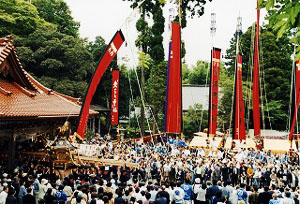

Total:35items
- Folk Performing Art (16)
- Kabuki (2)
- Noh & Kyogen (1)
- Festival (10)
- Wakubata woolen banner event of Kumakabuto Hatsuka Festival
- Hakone Feudal Lord's Procession Festival
- Uozu’s Tatemon Event
- Yama-age Event (Yama-age Festival)
- Yoshidanohimatsuri: Fire Festival of Yoshida
- Potato-comparing Festival in Nakayama, Oumi
- Noto's Kiriko Festival
- Ara-odori (Sankasho Shrine Festival)
- Mi-fune event in Kouchi Festival
- Nozawa Onsen Dosojin Festival
- Ritual & Ceremony (2)
- Puppet Play (2)
- Folk technology (2)

 |
|
 《Feature》
《Feature》This festival is the grand festival of Kumakabutoarakashihiko Shrine (Kumakabuto Shrine) and is called ‘Hatsuka Festival’ because it is held on September 20th every year.
The portable shrines from nineteen subordinate shrines in each community within the town come into the main shrine, with the chanting calls of ‘iyasakasaa’ and the lively sound of gong and drum through the guidance of Sarutahiko (Shinto god). These are accompanied by roughly twenty meter high, deep red colored wakubata woolen banners and tools.
After all the portable shrines enter into the front shrine, the Houhei Ceremony is held at the main shrine. Young people beat gongs and drums, and Sarutahiko dances to the sound throughout the grounds of the shrine.
[Government-Designated Significant Intangible Folk Cultural Asset]
Provided by Nanao City Tourism Association
Translation: Yoko Hokari, reviewed by Catherine Newman
| City/Town | Miyamae, Nakajima-Cho, Nanao City, Ishikawa Prefecture |
|---|---|
| Location | Kumakabuto Shrine(Held on September 20th every year) |
| Contact | Nanao City Tourism Association TEL: 0767-53-8424 |
| Access | Kumakabuto Shrine(Miyamae, Nakagima-cho, Nanao City)
Five minutes by Taxi from Notonakajima Station of Noto Tetsudou Nanao Line |
| Highlight/POI | After the festivity at the shrine, the portable shrines lead and move to Kamohara which is 700 meters away from the grounds of the shrine.
At Kamohara, “oneri” (parading / dancing) is performed. The festival heads to a climax when `shimadakuzushi` is displayed in which the wakubata are circled fast and tipped nearly to the ground. |



